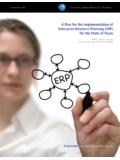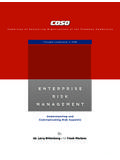Transcription of SAP-ABAP ENTERPRISE RESOURCE PLANNING …
1 SAP-ABAPENTERPRISE RESOURCE PLANNING (ERP):ERP is a package which provides solution for departmental functionalities of an ADVANTAGES: SAP can support any database at the back end. Platform independent. Supports multiple languages. Faster b/w networks. Can support any database in the backend. Transaction failure is very less comparing 2 other erp packages ( ).SAP life cycle implementation. Package evaluation. Project PLANNING and designing. Proto type. Gap analysis. Business process re-engineering. s/w installation and testing. End user training. Application transportation. Go live. Support and landscape: Development server (functional). Quality server( testing). Production server (end-user uses the system).Role of ABAPer: Screen creation. Table creation. Data migration.
2 Reporting. Redirecting SAP data from d-base to o/p devices.(scripts & forms).R/3 real time data advanced business application programming. If a language provides a d-base by default is called 4th generation ARCHITECTURE COMPONENTS:1. DISPATCHER - This component acts as an interface between the PL and AS. It receives user's request from PL and allocates a work area for each request from the WORK PROCESS - This component allocates memory area for each request received from dispatcher on a roll-in and roll-out basis. Once a request is processed, the memory area is rolled out to allocate for next request from DATABASE CONNECTIVITY- OPEN SQL - It receives each user's request in open SQL format (INSERT, UPDATE, DELETE, MODIFY) and converts them in native SQL format (Database used at the back end).
3 - NATIVE SQL - It checks for syntax errors in requests received and passes the request to database through gateway MESSAGE SERVICE - If there are any syntax errors in requests received, the Native SQL component uses message service to raise error messages for the end user from the message pool. Message pool is a container of user-defined and pre-defined GATEWAY SERVICE - If there is a distributed database at the back end, user's queries are redirected to appropriate database using gateway service. This component acts as an interface between AS and IS CLIENT IN SAP? CLIENT is the topmost hierarchy in SAP database. Each functional module in SAP is assigned a client. The objects developed by ABAPer for each module is stored in a package and request number and finally saved under a client number assigned for the particular development objects in SAP is divided into two types:REPOSITORY OBJECTS EXECUTABLE PROGRAMS INCLUDE PROGRAMS MODULE POOL PROGRAMS MESSAGE CLASSES SUBROUTINE POOLS FUNCTION GROUPS CLASS POOLSDATA DICTIONARY OBJECTS TABLES VIEWS DATA TYPES DOMAINS TYPE GROUPS SEARCH HELPS LOCK OBJECTSLOGGING INTO SAP:CLIENT : 800 USERNAME : SAPUSERPASSWORD : VITLANG : EN (OPTIONAL)CREATING A PACKAGE IN SAP:PACKAGE is a folder created by ABAPer to store his own development objects in to create a package.
4 Enter 'SE21' Tcode in Command Prompt area of SAP EAsy Access Screen -> Press Enter -> Opens Package Builder Screen -> Select Package Radiobutton -> Specify Package Name starting with Z or Y -> Click on Create pushbutton -> Opens an interface -> Enter Short Description for your package -> Select Software Component as HOME -> Click on Save -> OPens another interface to assign request number -> Click on CREATE REQUEST -> Opens interface -> Enter short description -> Click on Continue -> A Request number is 3created and assigned for your package -> Click on Continue -> A package is created -> Save -> Come PROGRAMS IN SAP EDITOR:SE38 is the Tcode used to open abap editor, where we create source to create simple program in SE38 Editor:SE38 -> Opens abap Editor Initial screen -> Specify program name starting with Z or Y -> Select Source Code radio button -> Click on Create pushbutton -> Opens another interface -> Enter short description for program -> Select Program type as Executable Program -> Click on Save -> Specify Package Name -> Assign request number -> Click on continue -> Opens abap Editor of abap Program: abap is not case sensitive.
5 abap is case sensitive only during comparison. Every abap statement should end with a period (full stop). CTRL+S shortcut key is used to save abap codes in editor. CTRL+F1 shortcut key is used to transform the screen into CHANGE/DISPLAY mode. CTRL+F2 shortcut key is used to check for syntax errors in source code. CTRL+F3 shortcut key is used to activate current :This concept is used to make the current object to be accessible by other objects within the same client or different client or vice versa. F8 function key is used to execute the abap program (Direct Processing). CTRL+< is used to comment the abap statement. CTRL+> is used to de comment the abap DECLARATION IN abap :DATA is the statement used to declare variables in code:DATA A TYPE = the above code, A is a variable of integer type.
6 A is assigned a value '100'. WRITE statement is used to print out the value of A. The output of a program is printed in LPS (list-processing screen). The default value of an integer data type is '0'. The default value of a character data type is 'NULL'. An integer variable takes 11 character spaces in LPS screen to print out its value and the value is printed in right-justified manner. The first 10 character space is used to print the value and the 11th character space is for sign (positive or negative). eg. code:DATA A TYPE I VALUE '-100'.WRITE A statement is used to assign data type for the variable statement is used to assign initial value for the GUIABAP screens can be created using the following two following statements are used in common:1. PARAMETERS to create input boxes, checkboxes and radio SELECTION-SCREEN BEGIN OF LINE - END OF LINE.
7 - This statement is used to create input fields in a same SELECTION-SCREEN COMMENT. - This statement is used to specify the positions and label names for each input field declared using begin of line - end of codeSelection-screen begin of comment 10(15) lb2 for field : a (10).selection-screen comment 50(15) lb3 for field : b(10).selection-screen comment (15) : c(10).selection-screen end of pushbutton 10(10) LB1 user-command = 'PRINT'.lb2 = 'enter A value'.lb3 = 'enter B value'.at 'PB1'.LEAVE TO :/ a, b . SELECTION-SCREEN statement is used to specify the position of input fields. There are two attributes for specifying position using this statement. They BEGIN OF POSITION A(10).SELECTION-SCREEN POSITION B(10).SELECTION-SCREEN END OF SELECTION-SCREEN BEGIN OF SCREEN - END OF This statement is used to create a screen in GUI.
8 A screen number should be specified for each user-defined screen. This screen can be called within the program using the following statement:CALL selection-SCREEN <screen_number>. BEGIN OF SCREEN 100 TITLE BEGIN OF BLOCK : CH1 AS CHECKBOX, CH2 AS CHECKBOX, CH3 AS END OF BLOCK BEGIN OF BLOCK : RB1 RADIOBUTTON GROUP A, RB2 RADIOBUTTON GROUP A, RB3 RADIOBUTTON GROUP END OF BLOCK PUSHBUTTON /10(10) LB1 USER-COMMAND END OF SCREEN BEGIN OF SCREEN 200 AS WINDOW TITLE : D(10), E(10), F(10).SELECTION-SCREEN END OF SCREEN = 'SELECT CHECKBOXES AND RADIOBUTTONS'.T2 = 'PARAMETERS'.at 'PB1'.CALL SCREEN SELECTION-SCREEN BEGIN OF BLOCK - END OF statement is used to create blocks within the screen SELECTION-SCREEN PUSHBUTTON.
9 - This statement is used to create pushbuttons in :SELECTION-SCREEN PUSHBUTTON <starting position>(pushbutton length) <label_Variable> USER-COMMAND <pushbutton name>.Whenever a pushbutton is created and executed, a system variable SY-UCOMM holds the arguments for the and AT SELECTION-SCREEN are the selection-screen events. Using these type of events, abap is called as event-driven programming. Whenever the selection-screen programs are executed, the order of execution of events will CODEPARAMETERS : A(10), B(10).SELECTION-SCREEN PUSHBUTTON /10(10) LB1 USER-COMMAND = 'PRINT A'.AT 'PB1'.LEAVE TO :/ A, the above code, AT SELECTION-SCREEN event is used to hold the event functionalities of the pushbuttons declared within the program. Whenever a pushbutton is created and executed, AT SELECTION-SCREEN event get event is used to declare initial display values for the pushbutton component in the system variable holds the arguments of pushbutton and passes these arguments dynamically to the TO LIST-PROCESSING statement is used to print the statements in LPS, because these statements cannot be printed inside executing the program, use 'BACK' statement in the command prompt of LPS to come back to the selection-screen and then come back to the CODE 2 PARAMETERS : A(10), B(10).
10 9 SELECTION-SCREEN PUSHBUTTON /10(10) LB1 USER-COMMAND PUSHBUTTON /10(10) LB2 USER-COMMAND = 'PRINT A'.lb2 = 'EXIT'.AT 'PB1'.LEAVE TO :/ A, 'PB2'.LEAVE SELECTION-SCREEN statement is used to create a blank line within the selection-screen SELECTION-SCREEN statement is used to draw a horizontal line within the selection-screen CODE:TABLES STALIN FOR * FROM MARA WHERE MTART IN :/ :/ STALIN-LOW, STALIN-HIGH, STALIN-SIGN, a range is created using SELECT-OPTIONS statement, SAP creates an internal table with the same variable name (STALIN in this case) in the background with the following fields:10 LOWHIGHSIGNOPTION11. SELECTION-SCREEN FUNCTION pushbuttons declared in the header part of the screen are referred to as FUNCTION KEYS. A user can be allowed to create only 5 function :SELECTION-SCREEN FUNCTION KEY <function_key_number>.






